(This is a multi-sensory stations of the cross that was created by Youth Specialties – with a few of my own adaptations.)
Materials Needed: Chant music, several copies of the Stations Instructions at each station.
Station 1: Sandals
Station 2: Perfume, cotton balls
Station 3: Coins
Station 4: Bread
Station 5: Grape juice, cups
Station 6: Rope
Station 7: Robe
Station 8: Large cross, pens, sticky notes
Station 9: Candles and matches or flameless candles
Station 10: Bowl with rocks in it
Station 11 and 12: nothing (besides the station instructions)
Station 1
God in the Flesh
The Word became flesh and made his dwelling among us.
—John 1:14
Today you’re invited on a journey through the last days and hours of Jesus’ life.
In front of you is a pair of sandals, the kind that any ordinary man or woman would wear.
As you begin this journey, focus on what it means for the eternal God to become a man. Think about what it means that Jesus once stood in sandals like these, just like any of us might.
The God who created the world stepped into an ordinary human body. Take time to meditate on the mystery, majesty, and humility of Jesus, the Son of God.
Station 2
Mary Anoints Jesus
Six days before the Passover, Jesus arrived at Bethany, where Lazarus lived, whom Jesus had raised from the dead. Here a dinner was given in Jesus’ honor. Martha served, while Lazarus was among those reclining at the table with him. Then Mary took about a pint of pure nard, an expensive perfume; she poured it on Jesus’ feet and wiped his feet with her hair. And the house was filled with the fragrance of the perfume. But one of his disciples, Judas Iscariot, who was later to betray him, objected, “Why wasn’t this perfume sold and the money given to the poor? It was worth a year’s wages.” He did not say this because he cared about the poor but because he was a thief; as keeper of the money bag, he used to help himself to what was put into it. “Leave her alone,” Jesus replied. “It was intended that she should save this perfume for the day of my burial. You will always have the poor among you, but you will not always have me.” —John 12:1-8
Mary poured out expensive perfume onto Jesus’ feet as an act of worship. Spray a few sprays on a cotton ball. Smell its fragrance. The fragrance may not be strong at first, but you will smell it for hours. It’s long-lasting.
Mary’s act of worship was pure…passionate…real…expensive…extravagant. And it touched the heart of Jesus.
Jesus knew he was headed to the cross, and Mary’s act of worship was a blessing to him.
How can you pour out your love to Jesus, extravagantly, in a way that will spread the beautiful fragrance of Jesus where you are?
When you leave, take the cotton ball with you. Let its fragrance remind you that we are called to live every moment of our lives in fragrant worship of Jesus.
Station 3
Judas Agrees to Betray Jesus
Then one of the Twelve—the one called Judas Iscariot—went to the chief priests and asked, “What are you willing to give me if I hand him over to you?” So they counted out for him thirty silver coins. From then on Judas watched for an opportunity to hand him over.
—Matthew 26:14-16
Judas was one of Jesus’ closest friends, one of the twelve disciples who had been with him for three years. He agreed to betray Jesus for just thirty silver coins.
Hold one or two of the coins in your hand. How could Judas betray Jesus, his friend, for money? How do you think Judas felt when he looked at the coins in his hand and realized what he had traded for them?
Is your own heart tempted to betray Jesus over material things? Take this time to talk with him about it.
Station 4
The Last Supper
After he had said this, Jesus was troubled in spirit and testified, “I tell you the truth, one of you is going to betray me.” His disciples stared at one another, at a loss to know which of them he meant. One of them, the disciple whom Jesus loved, was reclining next to him. Simon Peter motioned to this disciple and said, “Ask him which one he means.” Leaning back against Jesus, he asked him, “Lord, who is it?” Jesus answered, “It is the one to whom I will give this piece of bread when I have dipped it in the dish.” Then, dipping the piece of bread, he gave it to Judas Iscariot, son of Simon. As soon as Judas took the bread, Satan entered into him.
“What you are about to do, do quickly,” Jesus told him, but no one at the meal understood why Jesus said this to him. Since Judas had charge of the money, some thought Jesus was telling him to buy what was needed for the Feast, or to give something to the poor. As soon as Judas had taken the bread, he went out. And it was night. —John 13:21-30
Jesus was celebrating the Passover feast with his disciples.
Tear off a piece of bread and eat it as Jesus did. As you’re eating, think of the heartbreak he must have been feeling at the betrayal of one of his own disciples.
He knew his disciples would soon face confusion and fear. Contemplate his sorrow and compassion for them.
Station 5
Gethsemane
Then Jesus went with his disciples to a place called Gethsemane, and he said to them, “Sit here while I go over there and pray.” He took Peter and the two sons of Zebedee along with him, and he began to be sorrowful and troubled. Then he said to them, “My soul is overwhelmed with sorrow to the point of death. Stay here and keep watch with me.” Going a little farther, he fell with his face to the ground and prayed, “My Father, if it is possible, may this cup be taken from me. Yet not as I will, but as you will.”—Matthew 26:36-38
This scene reveals the sorrow in Jesus’ heart that night. He prayed to his Father that he would not have to go to the cross if there were any other way. Yet he prayed the hardest prayer any of us can pray: “Yet not as I will, but as you will.”
When Jesus said, “May this cup be taken from me,” he was referring to the difficult thing his Father was asking him to bear. Yet he chose to drink the cup, even though it was painful.
Pour a cup of grape juice and drink it. As you do, remember that Jesus chose to bear the agony of the cross—to drink the cup—for you.
Is there a cup that God is asking you to drink—something about which you need to pray the prayer of Gethsemane: “Yet not as I will, but as you will. Not as I want, but as you want.”
Station 6
Jesus’ Arrest
When he had finished praying, Jesus left with his disciples and crossed the Kidron Valley. Now Judas, who betrayed him, knew the place, because Jesus had often met there with his disciples. So Judas came to the grove, guiding a detachment of soldiers and some officials from the chief priests and Pharisees. They were carrying torches, lanterns and weapons. Jesus, knowing all that was going to happen to him, went out and asked them, “Who is it you want?” “Jesus of Nazareth,” they replied. “I am he,” Jesus said. (And Judas the traitor was standing there with them.) When Jesus said, “I am he,” they drew back and fell to the ground. Again he asked them, “Who is it you want?” And they said, “Jesus of Nazareth.” “I told you that I am he,” Jesus answered. “If you are looking for me, then let these men go.” This happened so that the words he had spoken would be fulfilled: “I have not lost one of those you gave me.” Then Simon Peter, who had a sword, drew it and struck the high priest’s servant, cutting off his right ear. (The servant’s name was Malchus.) Jesus commanded Peter, “Put your sword away! Shall I not drink the cup the Father has given me?” —John 18:1-11
Even though Jesus could have given the word and overpowered all the guards, he let himself be bound and led away.
Pick up the rope and hold it in your hands. As you do, remember that Jesus was bound with a rope like this one. He chose to submit to the difficult way of the cross with every step that he took.
Station 7
Jesus’ Trial
Those who had arrested Jesus took him to Caiaphas, the high priest, where the teachers of the law and the elders had assembled. But Peter followed him at a distance, right up to the courtyard of the high priest. He entered and sat down with the guards to see the outcome. The chief priests and the whole Sanhedrin were looking for false evidence against Jesus so that they could put him to death. But they did not find any, though many false witnesses came forward. Then the governor’s soldiers took Jesus into the Praetorium and gathered the whole company of soldiers around him. They stripped him and put a scarlet robe on him, and then twisted together a crown of thorns and set it on his head. They put a staff in his right hand and knelt in front of him and mocked him. “Hail, king of the Jews!” they said. They spit on him, and took the staff and struck him on the head again and again. After they had mocked him, they took off the robe and put his clothes on him. Then they led him away to crucify him. Matthew 26:57-60, 27:27-31
Imagine yourself in Peter’s shoes. You are looking out over the courtyard where Jesus is being tried and mocked. You know that he is being unjustly accused. As you stand here, you see men telling lies about him. You watch him being beaten, spit on, and ridiculed.
Here is the man you have followed for three years, the man you had put all your hope in, being sentenced to death. In your heart you have believed he is God, the promised Messiah of the Jewish people.
Your whole world is crashing around you, and worst of all, you have denied that you even know him.
Pick up the robe; hold it in your hands; put it on. As you do, think about how Jesus wore a robe like this and a crown of thorns on His head so that angry soldiers would wound and humiliate Jesus. What do you want to tell Jesus right now?
Station 8
The Crucifixion
As they were going out, they met a man from Cyrene, named Simon, and they forced him to carry the cross. They came to a place called Golgotha (which means The Place of the Skull). There they offered Jesus wine to drink, mixed with gall; but after tasting it, he refused to drink it. When they had crucified him, they divided up his clothes by casting lots. And sitting down, they kept watch over him there. Above his head they placed the written charge against him: THIS IS JESUS, THE KING OF THE JEWS. Two robbers were crucified with him, one on his right and one on his left. Those who passed by hurled insults at him, shaking their heads and saying, “You who are going to destroy the temple and build it in three days, save yourself! Come down from the cross, if you are the Son of God!” In the same way the chief priests, the teachers of the law and the elders mocked him. “He saved others,” they said, “but he can’t save himself! He’s the King of Israel! Let him come down now from the cross, and we will believe in him. He trusts in God. Let God rescue him now if he wants him, for he said, ‘I am the Son of God.’ “ In the same way the robbers who were crucified with him also heaped insults on him. —Matthew 27:32-44
Here is Jesus, dying a brutal death on a Roman cross, an instrument of torture. Kneel in front of the cross. Imagine yourself there at the scene. What is going through your mind? Don’t rush this part.
God’s great love for God’s children is the reason Jesus went to the cross. Jesus died on the cross in order to relieve all of us from our sins and our burdens. He could have answered the taunts by calling the angels of heaven to bring him down from the cross, but he didn’t. Because He loves us, and YOU, He chose to stay.
Near you are several pieces of paper and pens. Think of a burden (something that makes you feel pain in your life or worries you) or a sin or something that you did that you know hurts others or disappoints God and keeps you from God. Write it down on a piece of paper.
Take the paper, rip it up, and place it on the cross. As you rip it and place it no the cross, think about how your sins and burdens were nailed to the cross that day with Jesus. With each rip, remember Jesus’ words: “It is finished.” He bore the pain of the cross so you could be forgiven and set free from slavery to your sin and burdens.
Station 9
Jesus’ Death
From the sixth hour until the ninth hour darkness came over all the land. About the ninth hour Jesus cried out in a loud voice, “Eloi, Eloi, lama sabachthani?”—which means, “My God, my God, why have you forsaken me?” And when Jesus had cried out again in a loud voice, he gave up his spirit. At that moment the curtain of the temple was torn in two from top to bottom. The earth shook and the rocks split. The tombs broke open and the bodies of many holy people who had died were raised to life. They came out of the tombs, and after Jesus’ resurrection they went into the holy city and appeared to many people. When the centurion and those with him who were guarding Jesus saw the earthquake and all that had happened, they were terrified, and exclaimed, “Surely he was the Son of God!”
—Matthew 27:45-54
When Jesus died that day, so many people watching must have thought that their hopes had died as well. Darkness came over all the land that day.
Remember the darkness that covered the world that day. Think about the darkness that covers the world today in your neighborhood, school, church and among your friends, family, and classmates that is in need of the light of Jesus. (violence, depression, death of loved one, bullying, etc.)
How can you be a light of Christ to those who live in darkness around you? Light a candle and ask God to help you be Christ’s light to the world.
Station 10
Jesus’ Burial
As evening approached, there came a rich man from Arimathea, named Joseph, who had himself become a disciple of Jesus. Going to Pilate, he asked for Jesus’ body, and Pilate ordered that it be given to him. Joseph took the body, wrapped it in a clean linen cloth, and placed it in his own new tomb that he had cut out of the rock. He rolled a big stone in front of the entrance to the tomb and went away. Mary Magdalene and the other Mary were sitting there opposite the tomb. —Matthew 27:57-61
The rocks you see here are a fraction of the size of the rock that sealed Jesus’ tomb. Imagine the heaviness of it. Pick up one of these rocks. Feel its texture. Feel its weight.
Can you sense the heavy weight the disciples and those who loved Jesus must have felt as Jesus’ tomb was sealed? In their eyes, death had won. This was a stone that no one could move. It was final. Jesus was gone and buried.
Station 11
Jesus’ Resurrection
After the Sabbath, at dawn on the first day of the week, Mary Magdalene and the other Mary went to look at the tomb. There was a violent earthquake, for an angel of the Lord came down from heaven and, going to the tomb, rolled back the stone and sat on it. His appearance was like lightning, and his clothes were white as snow. The guards were so afraid of him that they shook and became like dead men. The angel said to the women, “Do not be afraid, for I know that you are looking for Jesus, who was crucified. He is not here; he has risen, just as he said. Come and see the place where he lay. Then go quickly and tell his disciples: ‘He has risen from the dead and is going ahead of you into Galilee. There you will see him.’ Now I have told you.” So the women hurried away from the tomb, afraid yet filled with joy, and ran to tell his disciples. Suddenly Jesus met them. “Greetings,” he said. They came to him, clasped his feet and worshiped him. Then Jesus said to them, “Do not be afraid. Go and tell my brothers to go to Galilee; there they will see me.”
—Matthew 28:1-10
Imagine the cold, heavy, anxious fear and sorrow that these women must have felt as they journeyed to the tomb that day. Imagine them arriving at the tomb and finding the stone rolled away, the empty grave clothes in the place where Jesus’ body was supposed to be.
Imagine the shock and the overwhelming joy they felt as they met the risen Jesus in the garden. Their Lord was alive! Imagine how these women were transformed in that one moment.
How do you think the risen Jesus wants to transform you today?
Station 12
Crossroads: What Will You Do with Jesus?
Then Jesus said to his disciples, “If anyone would come after me, he must deny himself and take up his cross and follow me.
—Matthew 16:24
You are at a crossroads.
Look over the Journey you have just taken through the final days of Jesus to the cross and beyond. Every step Jesus took was purposeful, deliberate, by plan. Every moment of pain, betrayal, and agony was borne by him out of love for you. You were—and still are—a part of his journey.
Jesus bore and carried your sins and burdens on the cross. Therefore, when you ask for forgiveness, you are freed from all sin and guilt. You can leave tonight knowing that Jesus journeys with you every day. You are not alone in your life journey.
You experienced tonight some of the emotions Jesus Christ experienced on his journey to the cross. You can leave here still holding on to parts of your life, the parts you don’t want to surrender. Or you can leave choosing to surrender everything to Him because He chose to do so for you.
If you feel led, tell Jesus that your life is His. Then ask Him to reveal to you what is in your life that keeps you from being fully in relationship with Him. Ask Him to guide you and help you make changes in your life so that He is first in your life.
Pray the prayer of Gethsemane: “Yet not as I will, but as you will.”
What is Jesus saying to you tonight? Stay at this station or sit in a pew or chair until everyone else is finished with the stations. Reflect, pray. You can write your response to Jesus, draw, think, etc. Take this time to respond to Jesus’ love for you.

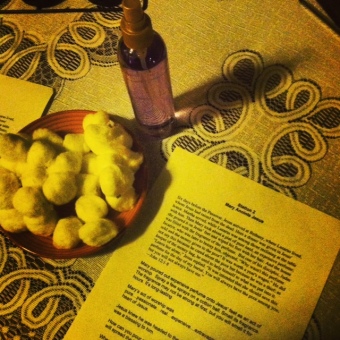




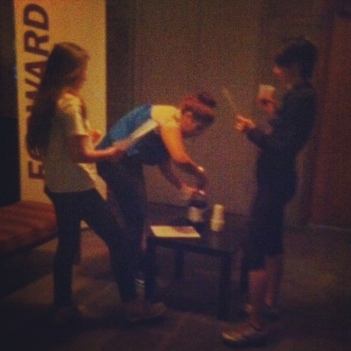



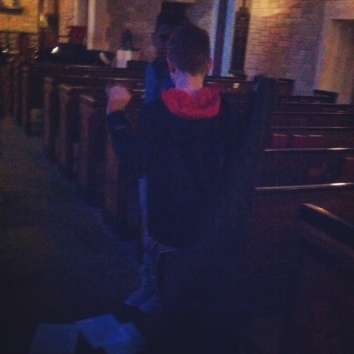


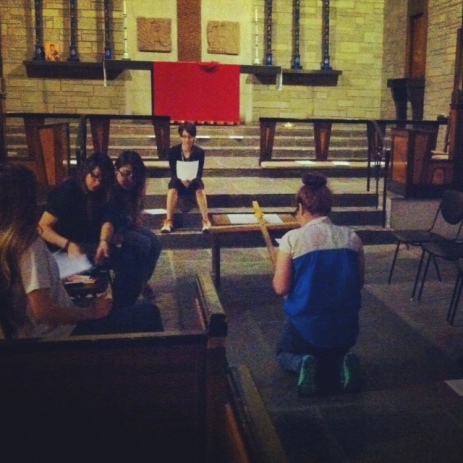

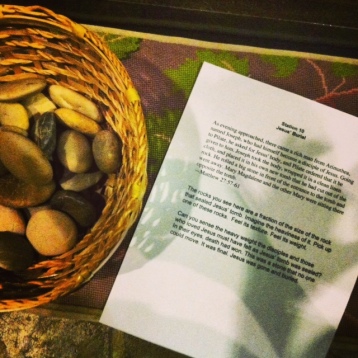


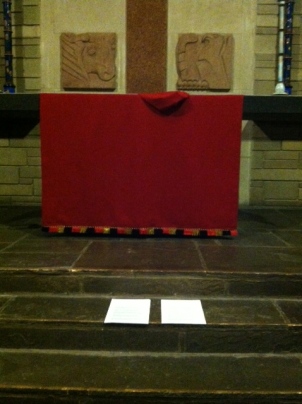

Pingback: Jesus receives strength | Bible Aid
Pingback: Eight Days | A Pastor's Thoughts
Thank you for the link! God bless you!
This is beautiful! Thank you for sharing!
Thank you, Emily Heitzman! I’m teaching 5th Grade Creed at Church of The Resurrection in New Albany on Thursday afternoons and this week, The Stations of The Cross is this week’s lesson plan. I will share your insightful reflections with my class. This is always one of the most meaningful lessons of the entire year, and the roots of my faith always reach deeper and provide an even stronger foundation to continue growing in faith and action. I’m praying with you that each student is moved to a deeper faith as we take this journey with Christ together.
Thanks, Ann! My youth will be doing these stations tomorrow night at youth group. We do this every year right before Holy Week, and they enjoy them and find meaning in them every time they do them. I hope everything went well with your 5th graders and that they were blessed as they experienced walking in the footsteps of Jesus through the stations, as well!
Pingback: 4 Ideas to Create an Atmosphere of Experience | Youth Ministry Unleashed
thank you very much for such lovely stations of the cross, they are really inspirational. gob bless your ministry. with love Fr. austin sdb
This is so good! Thank you!